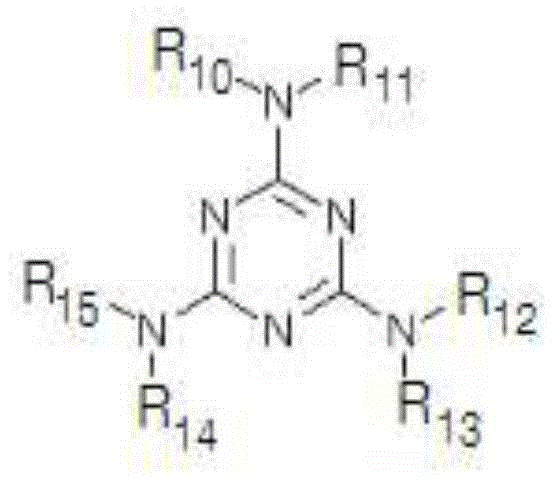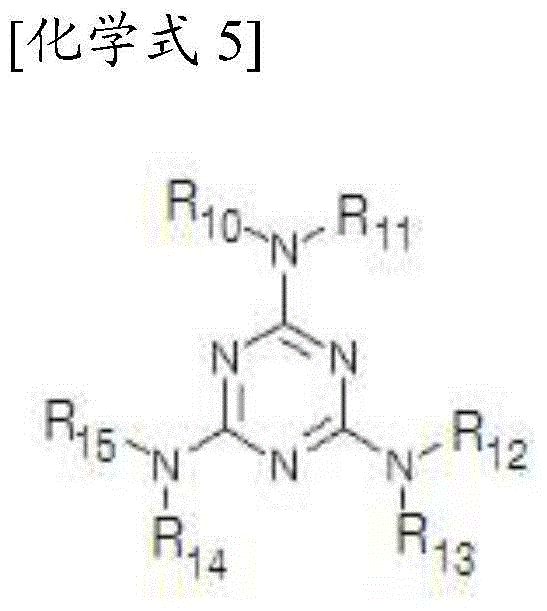Negative type photosensitive organic-inorganic hybrid insulating film composition
A photosensitive, insulating film technology, applied in the direction of organic insulators, insulators, plastic/resin/wax insulators, etc., can solve the problems of reduced aperture ratio of displays, large area of evaporation equipment, poor electrical properties of displays, etc., to achieve excellent panel reliability performance, process simplification and reduction of power consumption
- Summary
- Abstract
- Description
- Claims
- Application Information
AI Technical Summary
Problems solved by technology
Method used
Image
Examples
Synthetic example 1
[0091] Synthesis Example 1 : Production of siloxane copolymer (A)
[0092]30 parts by weight of phenyltriethoxysilane, 50 parts by weight of tetraethoxysilane and 20 parts by weight of acryloyloxypropyl trimethoxysilane were respectively put into a flask equipped with a cooling tube and a stirrer as a reactive silane, and 100 parts by weight of ethanol was put in as a solvent, and it stirred slowly after replacing with nitrogen. After adding 40 parts by weight of ultrapure water and 3 parts by weight of oxalic acid as a catalyst to the reaction solution, the mixture was stirred again slowly. One hour later, the temperature of the reaction solution was raised to 60° C., and the temperature was maintained for 10 hours to carry out solution polymerization, and then cooled to normal temperature to complete the reaction. Further, it was quenched to below 0° C. to precipitate the reactants. In addition, after removing the supernatant containing unreacted silane, the alcohol solve...
Synthetic example 2
[0093] Synthesis example 2 : Production of siloxane copolymer (B)
[0094] 30 parts by weight of phenyltriethoxysilane, 50 parts by weight of tetraethoxysilane and 20 parts by weight of acryloyloxypropyl trimethoxysilane were respectively put into a flask equipped with a cooling tube and a stirrer as a reactive silane, and The solvent was not put in, and it stirred slowly after replacing with nitrogen. After adding 40 parts by weight of ultrapure water and 2 parts by weight of nitric acid as a catalyst to the reaction solution, the mixture was stirred again slowly. One hour later, the temperature of the reaction solution was raised to 60° C., and the temperature was maintained for 10 hours to perform bulk polymerization, and then cooled to normal temperature to complete the reaction. Further, it was quenched to below 0° C. to precipitate the reactants. In addition, after removing the supernatant containing unreacted silane, the alcohol solvent and residual moisture generat...
Synthetic example 3
[0095] Synthesis example 3 : Production of siloxane copolymer (C)
[0096] In the above Synthesis Example 1, 40 parts by weight of diphenyldimethoxysilane, 40 parts by weight of tetraphenoxysilane and 20 parts by weight of vinyltriethoxysilane were respectively put into a flask equipped with a cooling tube and a stirrer as Reactive silane was carried out in the same manner as in Synthesis Example 1 above except for this. As a result of the final GPC analysis, a siloxane copolymer having a polystyrene-equivalent weight average molecular weight (MW) of 13,000 was produced.
PUM
| Property | Measurement | Unit |
|---|---|---|
| thickness | aaaaa | aaaaa |
Abstract
Description
Claims
Application Information
 Login to View More
Login to View More - R&D
- Intellectual Property
- Life Sciences
- Materials
- Tech Scout
- Unparalleled Data Quality
- Higher Quality Content
- 60% Fewer Hallucinations
Browse by: Latest US Patents, China's latest patents, Technical Efficacy Thesaurus, Application Domain, Technology Topic, Popular Technical Reports.
© 2025 PatSnap. All rights reserved.Legal|Privacy policy|Modern Slavery Act Transparency Statement|Sitemap|About US| Contact US: help@patsnap.com



